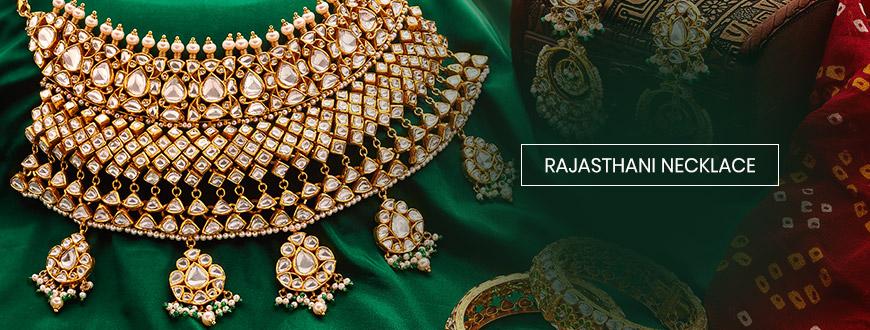Kalyan Wiki

Rajasthani Necklace
When the entire world was swooning over gold, diamond and other precious stones, Rajasthani's held their silver, copper and brass ornaments close to their hearts. This persistence and love for their culture lead the world to embrace Rajasthani jewellery. We can witness even Hollywood and Bollywood celebrities walking around in these intricate ornaments.
There are numerous statement pieces when it comes to Rajasthani jewellery. However, here we will try to decode the colossal world of Rajasthani necklaces.
Rajputi Aad: Primarily Rajasthani women love to adorn their choker and rani haar. Rajputi Aad is a form of choker that was able to attain a lot of attention back in the day and is currently popular among brides. It is a necklace with a huge elongated pendant that has pearls and precious stones. These Rajasthani necklaces are available in abundant designs. The elaborate pendant is the centre of attraction here and is available in numerous geometrical designs. Polki, meenakari, floral motifs and enamel work are prominent on these Rajasthani necklaces.
Timaniya: Timaniya or Tediya means 'three gemstones' and is another form of a choker. It is a smaller version of an 'Aad'. Multiple pearl strings are attached to an elaborate pendant that is designed in neat geometrical shapes, mostly rectangular. Uncut diamonds, pearls and kundan stones are an integral part of this Rajasthani necklace. These may not be essentially worn as chokers as sometimes the pearl strings are enlarged and these make beautiful long necklaces.
Hansuli: Hansuli is a Rajasthani tribal necklace. However, it has made its place as a contemporary silver ornament that compliments both western and Indian attire. It is a striking collar made entirely in silver. The artisans leave it hollow so that it is comfortable to wear. There are lots of versions made of this intricate ornament. The single-piece pendant that was the attraction in traditional Rajasthani Hansuli is being cut into numerous shapes. Motifs and enamel work too are extensively used in this piece of jewellery.
Rani Haar: As the name suggests, this is an alluring neckpiece of royal origin. These are long necklaces with multiple layers of gold, pearls and precious stones. The exotic combination of stones makes it a perfect choice for your D-day. A typical Rajasthani rani haar has extensive kundan work all over it, and it lends the feeling of a real queen donning it. And why not, because every girl is a queen on her special day. This Rajasthani necklace consists of more than five layers interconnected with tiny pendants and a chunky necklace. Kundan and meenakari work are the essential parts of Rajasthani rani haar.
Rajasthan has gifted the world with enamel work, motifs, meenakari and kundan work. However, there is much more to the Rajasthani jewellery culture.
Thewa is one such style of jewellery making that is visible in most of the Rajasthani necklaces. In this style, gold sheets are intricately designed over molten glass. We can witness these works on most of the pendants of Rajasthani necklaces. Traditionally 23K gold is used in this process, and the delicate work is done on multicoloured molten glass. The overall effect that this work has on a necklace cannot be expressed in words.
In the same way, Jharokhas too are blended into Rajasthani necklaces as pendants. Both these designs belong to the traditional Rajasthani art of jewellery making and are famous.
Donning Rajasthani necklaces can bring you closer to the royal culture.







